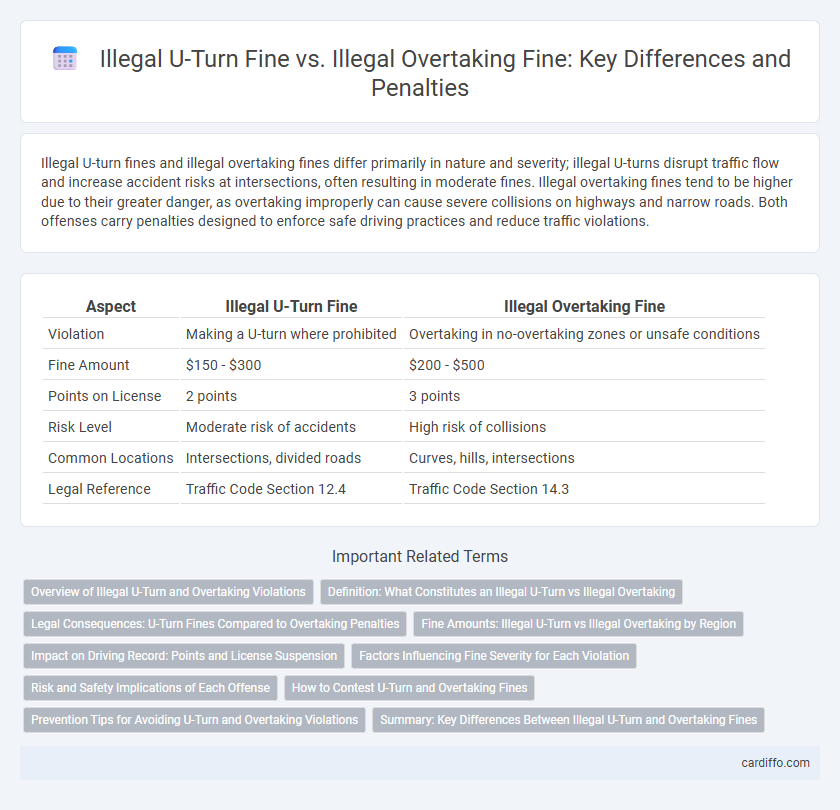Illegal U-turn fines and illegal overtaking fines differ primarily in nature and severity; illegal U-turns disrupt traffic flow and increase accident risks at intersections, often resulting in moderate fines. Illegal overtaking fines tend to be higher due to their greater danger, as overtaking improperly can cause severe collisions on highways and narrow roads. Both offenses carry penalties designed to enforce safe driving practices and reduce traffic violations.
Table of Comparison
| Aspect | Illegal U-Turn Fine | Illegal Overtaking Fine |
|---|---|---|
| Violation | Making a U-turn where prohibited | Overtaking in no-overtaking zones or unsafe conditions |
| Fine Amount | $150 - $300 | $200 - $500 |
| Points on License | 2 points | 3 points |
| Risk Level | Moderate risk of accidents | High risk of collisions |
| Common Locations | Intersections, divided roads | Curves, hills, intersections |
| Legal Reference | Traffic Code Section 12.4 | Traffic Code Section 14.3 |
Overview of Illegal U-Turn and Overtaking Violations
Illegal U-turn violations occur when a driver makes a U-turn at a prohibited location, often marked by traffic signs or road markings, posing significant risks to oncoming traffic and pedestrians. Illegal overtaking violations involve passing another vehicle in no-overtaking zones or unsafe conditions, increasing the likelihood of head-on collisions and road accidents. Fines for both offenses vary by jurisdiction but are enforced strictly to improve road safety and prevent traffic hazards.
Definition: What Constitutes an Illegal U-Turn vs Illegal Overtaking
An illegal U-turn occurs when a driver reverses direction at a location where such a maneuver is prohibited by traffic signs or road markings, compromising safety and flow. Illegal overtaking involves passing another vehicle in a restricted zone, such as no-passing lines, curves, or intersections, posing significant collision risks. Both violations disrupt traffic regulations designed to prevent accidents and maintain orderly movement on the roads.
Legal Consequences: U-Turn Fines Compared to Overtaking Penalties
Illegal U-turn fines typically carry penalties such as a monetary fine ranging from $100 to $250 and may include demerit points on the driver's license, depending on jurisdiction. Illegal overtaking fines often result in higher financial penalties, possibly exceeding $300, along with increased demerit points and potential license suspension due to the higher risk of accidents associated with overtaking violations. Legal consequences for illegal overtaking are generally more severe due to the increased danger posed, reflecting the stricter enforcement policies and elevated safety concerns in traffic law regulation.
Fine Amounts: Illegal U-Turn vs Illegal Overtaking by Region
Illegal U-turn fines and illegal overtaking fines vary significantly by region, with some areas imposing higher penalties for overtaking due to increased accident risks. For example, in countries like India and UAE, illegal overtaking fines can reach up to $200, whereas illegal U-turn fines typically range from $50 to $100. European nations such as Germany and the UK levy fines around EUR70-150 for illegal U-turns, while illegal overtaking fines often exceed EUR100, reflecting the stricter enforcement on overtaking violations.
Impact on Driving Record: Points and License Suspension
Illegal U-turn fines typically add fewer penalty points to a driving record compared to illegal overtaking fines, which carry heavier point penalties due to higher risk factors. Accumulating points from illegal overtaking can lead to quicker license suspension, reflecting the severity of this violation on road safety. Repeated offenses in either category contribute to increased insurance premiums and stricter monitoring by traffic authorities.
Factors Influencing Fine Severity for Each Violation
Illegal U-turn fines vary based on factors such as location, traffic conditions, and prior offenses, with higher penalties imposed in high-risk or congested areas. Illegal overtaking fines depend on the speed limit violation, road type, and the presence of road markings, often resulting in harsher penalties due to increased accident risks. Enforcement intensity and accident history in the area also significantly influence fine severity for both types of violations.
Risk and Safety Implications of Each Offense
Illegal U-turn fines address the high risk of collisions caused by unexpected lane changes and sudden vehicle movements, which often result in head-on or side-impact crashes at intersections. Illegal overtaking fines target the dangers of unsafe passing maneuvers, where vehicles cross into oncoming traffic lanes, significantly increasing the chance of high-speed frontal collisions and multi-vehicle pile-ups. Both offenses compromise road safety, but illegal overtaking typically presents a higher risk of severe accidents due to greater speed differentials and reduced reaction times.
How to Contest U-Turn and Overtaking Fines
To contest an illegal U-turn fine, gather evidence such as dashcam footage or photos showing proper signage or unclear road markings, then file a formal appeal with traffic authorities specifying these details. For illegal overtaking fines, document the circumstances with GPS data or witness statements to prove safe maneuvering or emergency conditions before submitting a written dispute to the relevant department. Both processes require timely submission of appeals, often within 30 days, and may involve attending a hearing to present your case effectively.
Prevention Tips for Avoiding U-Turn and Overtaking Violations
Maintaining awareness of road signs and adhering to lane discipline are crucial for avoiding illegal U-turn and overtaking fines. Drivers should plan routes in advance to minimize risky maneuvers and use designated turning points and overtaking zones only. Regularly checking mirrors and signaling intentions clearly helps prevent violations and ensures safer driving behavior.
Summary: Key Differences Between Illegal U-Turn and Overtaking Fines
Illegal U-turn fines are typically imposed for unsafe or prohibited turns that disrupt traffic flow and increase accident risk, often carrying lower penalties compared to illegal overtaking. Illegal overtaking fines address dangerous maneuvers that involve passing vehicles in restricted zones or unsafe conditions, usually resulting in higher fines and stricter penalties due to the increased potential for head-on collisions. Understanding the differences in fine severity, applicable road regulations, and safety implications is essential for compliance and road safety optimization.
Illegal U-turn Fine vs Illegal Overtaking Fine Infographic

 cardiffo.com
cardiffo.com